Chert is a very popular rock with collectors, myself included. It is relatively common and can be found all over the world, yet it comes in almost limitless varieties and colors. Despite its popularity, there are a lot of misconceptions about chert. I thought it would be helpful to go over what chert is, how to identify it, and how it differs from closely related rock types.
Chert is a biochemical sedimentary rock made from microcrystalline quartz. It is very hard – registering a 7 on the Mohs hardness scale, and displays conchoidal fracturing. Chert can almost any color, but is usually gray, brown, red, or green. It has many subvarieties including flint, jasper, agate, and onyx.
While chert is a clearly defined rock type, it can still be difficult to know whether a rock you’ve found is chert, especially when you consider there are so many subvarieties that can appear quite different from one another. It can easily be confused for similar, closely related rocks. I’ll walk you through how to identify chert, what different varieties look like, and where it can be found.
What Does Chert Look Like?
Chert comes in so many distinct varieties that it can be difficult to describe what it looks like. One piece of chert might look almost entirely different from the next, depending on how it was formed and what impurities are present. Still, there are general attributes that practically all cherts share if you know what to look for.
In general, chert looks like a mass of sediment with relatively smooth, waxy-looking surfaces. It displays conchoidal fracturing resulting in very sharp edges. Chert can be almost any color but is most commonly grey, brown, reddish, or light green. Most varieties are opaque, but it can also be translucent.
Pro Tip: I have created the best rock identification system you’ll find anywhere. It’s made to help everyone from brand new hobbyists to university Geology students, and includes an eBook, digital tools, a video tutorials. Find out more here!
While all chert fits this general description, there is still quite a bit of variability from specimen to specimen. Because there is so much variation, it is perhaps easiest to briefly describe what each individual type looks like. Each of these varieties forms in a slightly different way, and it can have a drastic impact on what the final rock looks like.
Common Varieties of Chert
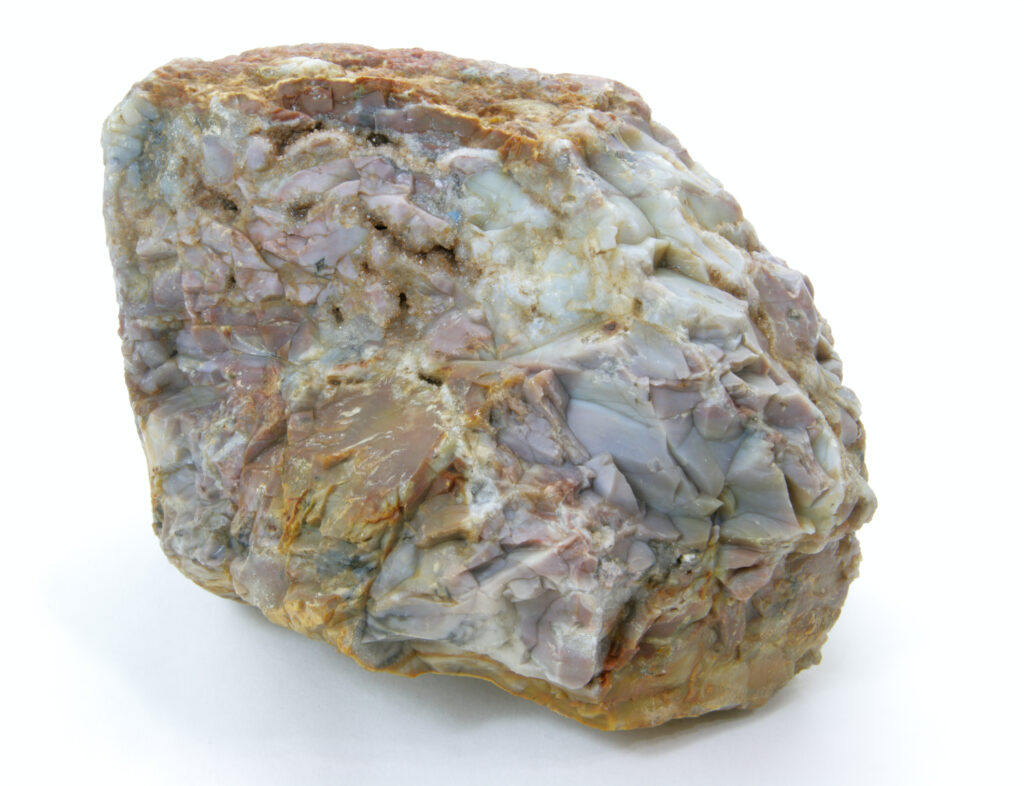
Common Chert
Normal, common chert is opaque and usually greyish or brownish, but can also have shades of red, green, and blue. It displays conchoidal fracturing the result in sharp edges. It is otherwise fairly nondescript, with no apparent banding. It often forms in limestone layers and is the most common form of chert.
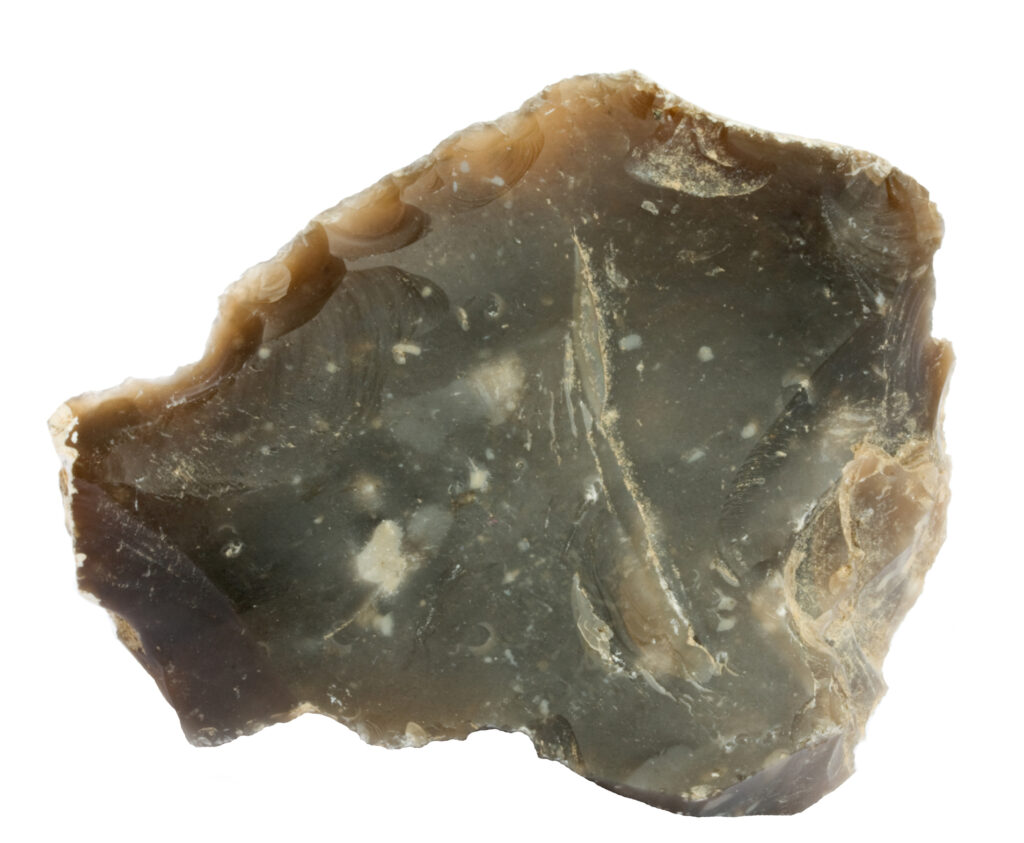
Flint
Flint is very similar to common chert in most respects, but it is often distinguished by geologists and collectors for its quality and coloration. Flint is considered to be higher-grade material and is almost always dark gray or black due to organic impurities. It has historically been used to make sharp tools like knives and arrowheads.
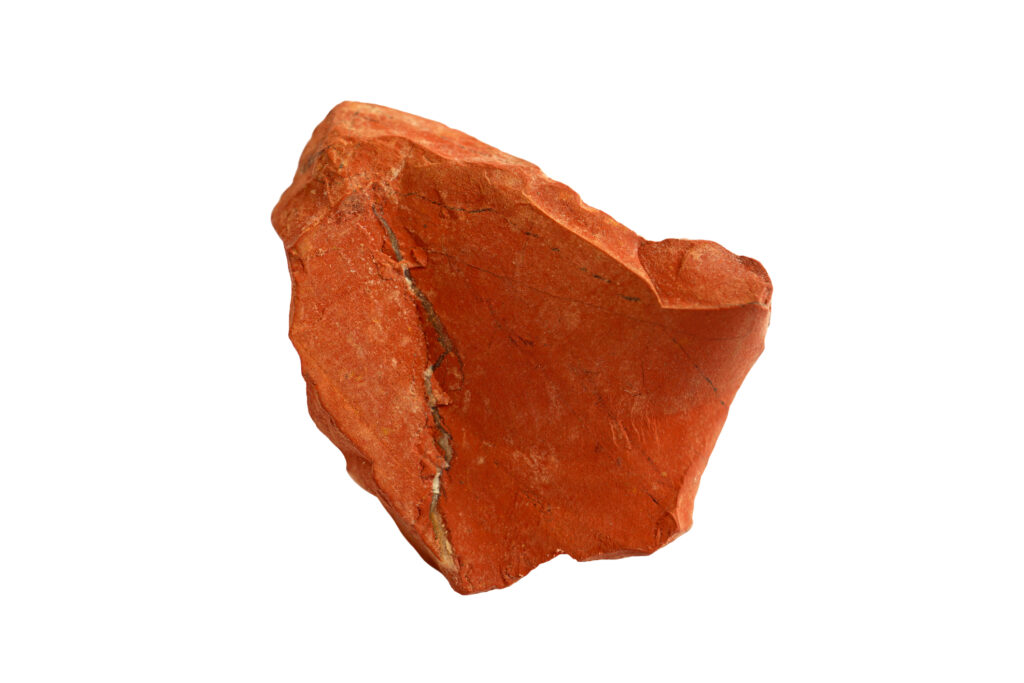
Jasper
Jasper is an opaque variety of chert that forms in association with igneous rocks. It forms in the void spaces of lava flows and gets its red coloration from impurities like iron and hematite. It is very popular with collectors for its bright colors, and it comes in many subvarieties itself. Jasper can sometimes grade into agate, which is sometimes referred to as jasp-agate.
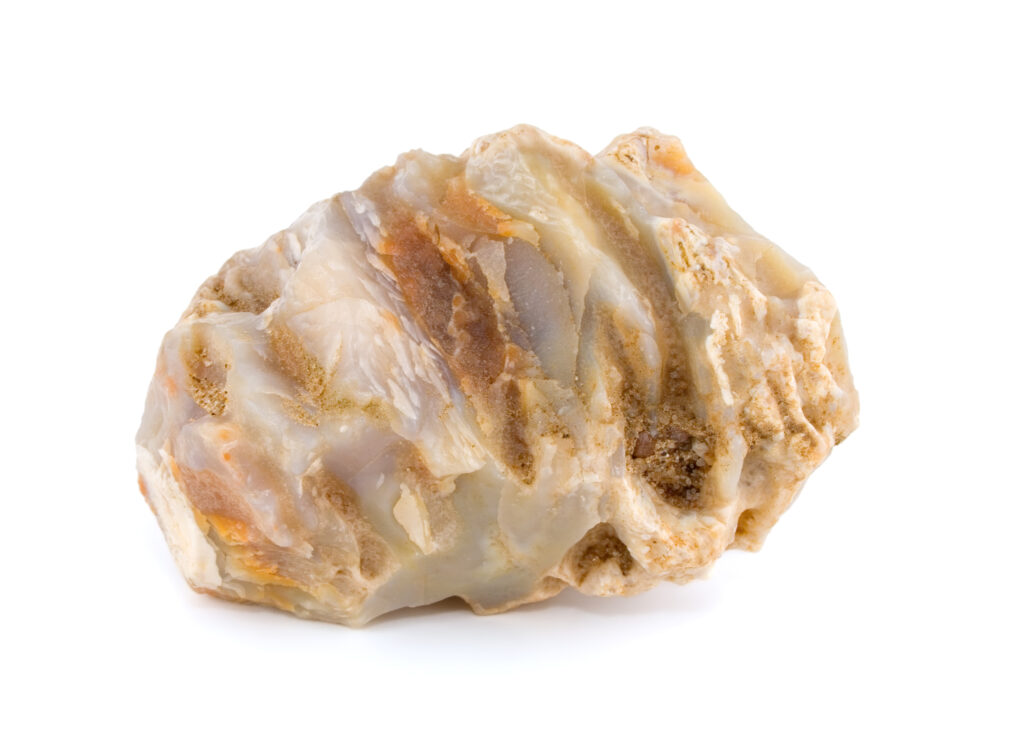
Chalcedony
Chalcedony is very similar to common chert, but is usually distinguished by its translucency. If you hold a light behind a piece of chalcedony you’ll be able to see the light shining through. Chalcedony is almost always off-white or otherwise lightly colored. It is common for chalcedony and chert to be intermixed with one another.
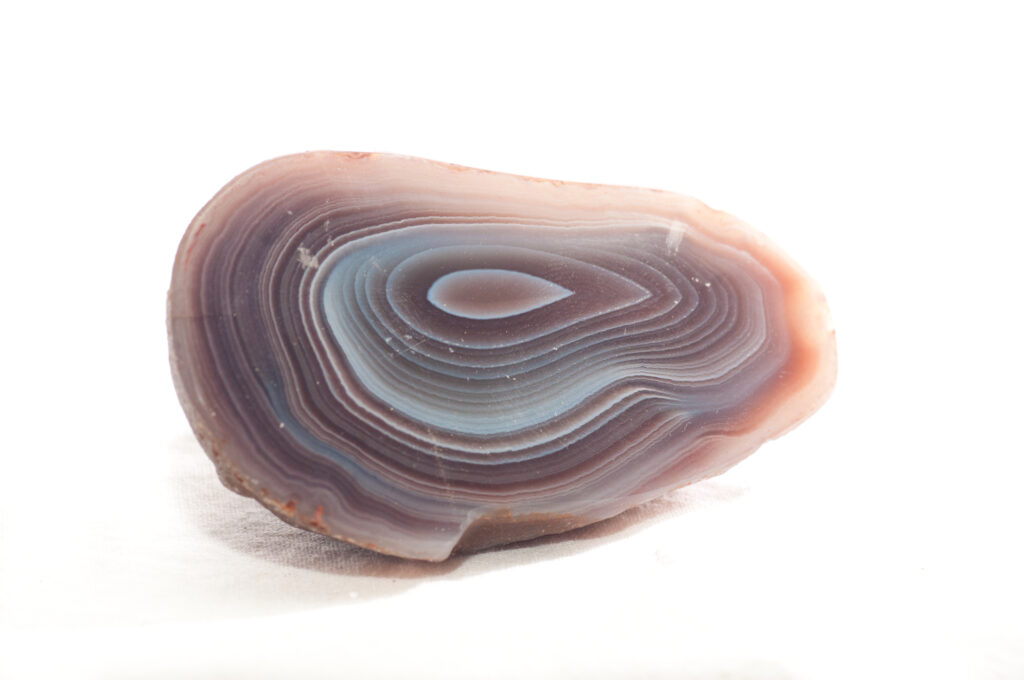
Agate
Agate is a subvariety of chalcedony. Like all chalcedony, agate is translucent, but agate is further defined by its colorful banding. It is highly sought after by collectors and is usually polished or cut to show off its beautiful alternating bands of color. There are many varieties of agate, each with their own characteristics and colors.
There are even more varieties of chert than those I have listed here, but these are by far the most common and the ones most sought-after by enthusiasts. These varieties can be broken down even further based on their coloration, banding habits, location, etc., but that is beyond the scope of this article.
The variation seen in chert is mostly due to two things: impurities and crystal habits.
Color is Driven by Impurities
Chert is, by definition, made almost entirely of microcrystalline quartz – the mineral version of SiO2. Pure quartz is almost completely transparent, so if chert were made of pure microcrystalline quartz you’d be able to see through it like glass.
But we know that’s not the case with almost any piece of chert found in nature. This is because chert is laden with impurities in the form of trace elements, and each of these impurities contributes some coloration.
Some of the most common impurities in chert are iron, aluminum, manganese, sodium, and calcium. Organic material and water are also frequently included in the fabric of chert. Each of these impurities has a distinct color associated with it. For instance, enough iron will turn chert red, as seen in many varieties of jasper. Similarly, organic material will turn it dark gray or black as seen in flint.
Pro Tip: To get a better look at the crystals in your rocks and help with identification I highly recommend picking up a good geologist’s hand lens.
Translucent or Opaque?
You might be wondering why some varieties of chert are opaque while others are translucent. The answer is actually twofold, and they work in conjunction with one another.
The amount and type of impurities in chert are significant contributors to how translucent it is. If there are a lot of trace elements present, especially dark ones like iron and organics, then the rock is much more likely to be opaque. Conversely, a smaller amount of light-colored impurities are likely to produce a transparent variety of chert like agate or chalcedony.
But impurities aren’t the only (or even the most significant) contributor to cherts diaphaneity (how light passes through a rock).
Chert is made of microcrystalline quartz, but not all microcrystalline quartz forms the same way. All of the tiny crystals are too small to see with the naked eye, but sometimes they are blocky and other times they are more elongated or fibrous.
Translucent varieties of chert like chalcedony and agate are made of more fibrous microcrystals, while opaque varieties like flint and common chert are made of blockier crystals. This small change has a drastic impact on how easily light passes through a specimen.
How to Identify Chert
By now you might be thinking that chert must be difficult to identify, especially with so many different-looking variations. But, in most cases, chert is pretty easy to recognize if you know what to look for. As with any rock, it is important to take a systematic approach when identifying chert and its variants.
Chert usually has a waxy luster, with conchoidal fracturing that results in sharp edges. All chert is very hard and cannot be scratched by steel. Some varieties are opaque, while others are translucent. It may be almost any color but is usually gray or brown, and sometimes displays alternating bands of color.
Conchoidal fracturing is a very good diagnostic characteristic when trying to identify chert. It looks like someone has scooped out part of the rock with a spoon, resulting in smooth, convex depressions on the surface of the rock. These shapes are usually lined with edges that can be very sharp, which is why chert and flint were so desirable for making tools like arrowheads and primitive knives.
Your rock may not display clear conchoidal fracturing. There are also some other rock types (like obsidian) that fracture conchoidally but aren’t chert. Therefore, some additional tests and observations are often useful.
A simple hardness test is one of the best ways to check for chert. Since it is almost entirely made of quartz, chert is exceptionally hard – registering a 7 on the Mohs hardness scale. This is harder than steel! Use a steel nail and try to scratch your rock. If it doesn’t leave a scratch, then your rock is very hard (most likely quartz) and could potentially be chert.
Since chert is made of silica (quartz) and not calcite or dolomite it will not react with acid. If you’ve already performed a hardness test and your rock is harder than steel, it is not even necessary to conduct this test since both calcite and dolomite are much softer than steel.
In summary, a rock must meet all of these requirements to be considered chert:
- Chemical or Biochemical – A sedimentary rock formed from the solidification of microscopic silica particles
- Very Fine-grained – Individual grains are too small to see, even with a hand lens
- Very Hard – Cannot be scratched by steel (7 on the Mohs hardness scale)
Beyond that, the many varieties of chert almost need to be identified seperately. The opaque varieties like flint and common chert usually have a waxy appearance. The translucent varieties like agate and onyx usually display colorful banding. Once you see each variety a few times they become very easy to identify, especially with the aid of the simple tests described above.
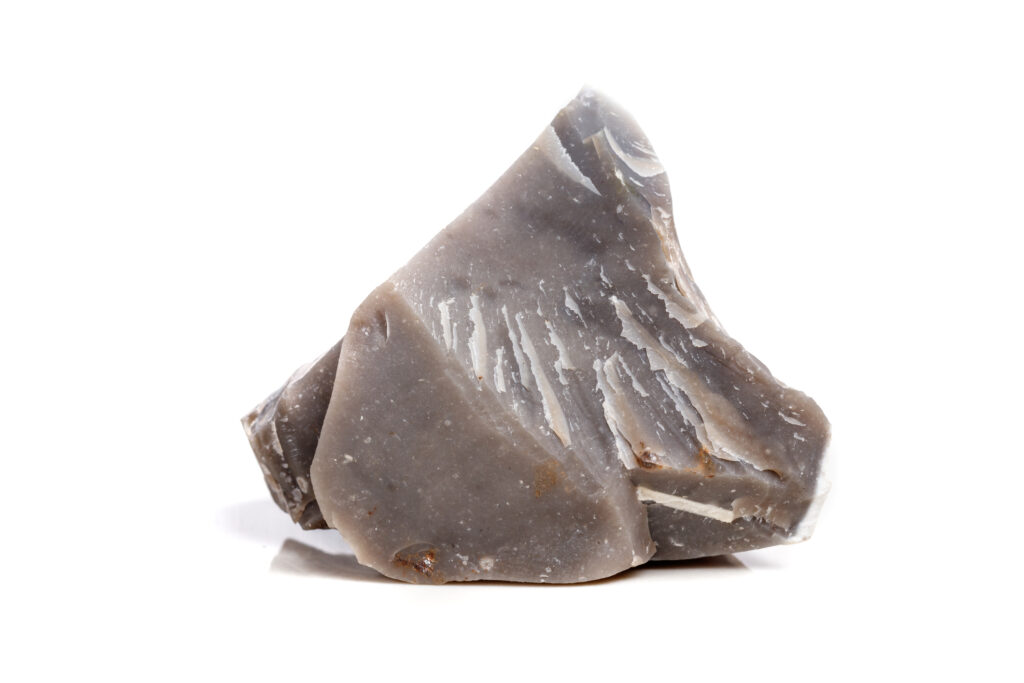
If your rock meets all of those criteria then it is very likely chert, or at least something very closely related. There are, however, a few closely related rocks that people sometimes confuse for sandstone.
- Obsidian – Might be confused for chert or flint due to smooth texture and conchoidal fracturing. Softer than chert, with a glassier texture.
- Micrite – Similar texture and color to chert and also sedimentary in origin, but much softer than chert and it reacts with acid.
- Crystalline Quartz – Same hardness as chert, but is one large, single crystal with defined, flat faces. Usually translucent or transparent.
Tip: This article is part of my sedimentary rock identification series. To read more about how to identify all igneous rocks, check out my article here.
What Is Chert Made Of?
It might seem silly to even ask this question. We have already seemingly answered this question earlier in this article – chert is made of microcrystalline quartz, right? But the real answer can be a little more involved than that. So, what exactly is chert made of?
In general, chert is made of microcrystalline or cryptocrystalline quartz, the mineral version of SiO2. These tiny quartz crystals are fused together to form a solid, glassy mass. Varieties of chert also contain impurities in the form of trace elements like aluminum and iron, as well as organics or water.
The microscopic quartz crystals are usually the hard, petrified remains of organic sediment that settle on the ocean floor. Certain creatures in the sea, both past and present, leave behind tiny siliceous shells when they die. These remains are the building blocks of biochemical chert, which is thought to be by far the most common way it forms.
When chert forms biochemically, it is technically mostly made of very small fossils. These fossils are too small to see without high-powered magnification, but they are fossils nonetheless. Organisms like diatoms and radiolarians secrete silica-based shells instead of calcite like most of the seashells we’re familiar with.
But sometimes, chert is made not from the remains of living things but instead from tiny quartz crystals that precipitate out of water. For example, most petrified wood is made from one variety of chert or another. This happens when the soft woody material is slowly replaced by silica suspended in circulating groundwater. In this case, chert is made of nothing more than microscopic quartz crystals and a few impurities.
Large fossils like seashells and coral are possible in chert, but are relatively rare. If they are present, it is usually in biochemical cherts. Visible fossils in chert aren’t as common as they are in other sedimentary rock types like limestone and sandstone.
Where Is Chert Found?
By now you are probably asking yourself where you can find some chert of your own. Or maybe you’ve already found a rock that you suspect might be chert and you’re wondering if it occurs in your area. Chert is a fairly common rock type and it occurs in locations all around the globe, but it helps to know the general settings in which it can be found.
In general, chert is found interbedded with shale and limestone, either as continuous beds or as nodules. Some inorganic varieties of chert like jasper and agate are more likely to be found in areas with a history of volcanism. Still more varieties may be found near hot springs and in banded iron formations.
Biochemical chert, formed from the collection and solidification of tiny silica fossils at the bottom of the ocean, is most likely to be found in areas with a geologic history of low-energy marine environments like deep ocean water. These same environments are prone to creating shale, so it is common to find chert beds associated with shale.
You can look for chert formations near you using this excellent interactive map from the USGS. I have a video about how to use this tool in my Practical Rock Identification System, plus even more information on how to identify chert and other rocks.
Usually, you’ll find chert formations near other sedimentary rocks like limestone, mudstone, and shale. These rocks tend to form in cycles and groups related to the relative water levels at the time of deposition.
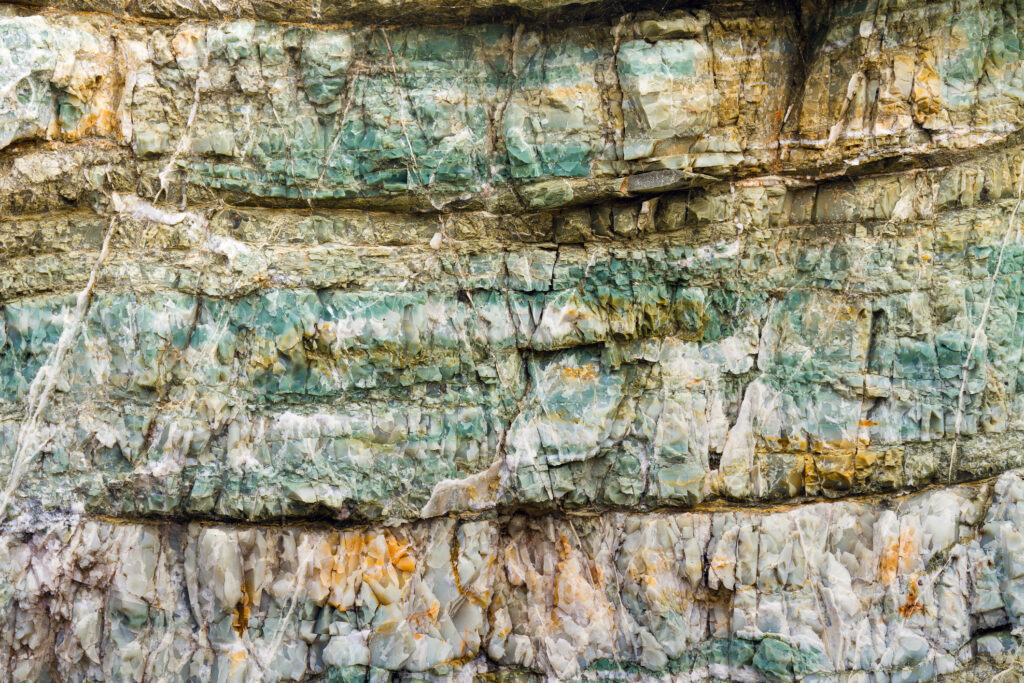
How Does Chert Form?
We’ve learned all about what chert looks like, what it is composed of, and generally where it’s found, but I have only briefly touched on how it’s actually formed. The creation of chert is not all that straightforward. It can actually occur in multiple ways, but always follows a few simple rules.
Most chert forms when large quantities of microscopic skeletons made of quartz fall to the ocean bottom, rapidly become buried and are gradually cemented together. Other varieties form when silica precipitates out of solution and replaces existing structures, such as nodules or petrified wood.
The processes by which chert form are actually quite complicated and sometimes not well understood. Many of the microscopic fossil types that form biochemical chert are thought to originally be made of opal (a hydrated version of microcrystalline quartz) which is later transformed into silica.
For chert types like agate and jasper, the process is quite different. They usually form in the old gas bubbles of basalt flows, and are therefor usually roughly spherical in shape. Silica-laden water slowly seeps through the rock and enters these voids, gradually leaving behind silica and filling up them up. Small changes in the chemistry of the water are responsible for the changes in color you see in banded agates.
What Is Chert Used For?
Chert has a long history of practical use all around the world, and continues to be popular for many reasons even today.
Chert has historically been used for practical tools like knives and arrowheads due to its conchoidal fractures and sharp edges. Flint has also long been used as a primitive means to start fires. High quality varieties of chert like flint, jasper, and agate remain popular materials for jewelry and decoration.
Agate in particular is a really fun rock to work with. It is probably the most popular rock type for lapidary artists and for tumbling because of its brilliant patterns and its ability to accept a nice polish.
You don’t usually see chert used for construction or building purposes. It doesn’t usually occur in large enough quantities to facilitate building stones, and there are problems with its chemistry and tendency to fracture that make it impractical to use even as aggregate or filler material.
This article is part of my rock identification series. To learn more about identifying rocks, check out my full in-depth guide here.
